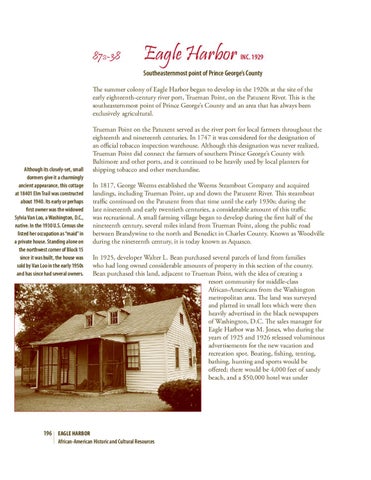87B-38
Eagle Harbor
INC. 1929
Southeasternmost point of Prince George’s County The summer colony of Eagle Harbor began to develop in the 1920s at the site of the early eighteenth-century river port, Trueman Point, on the Patuxent River. This is the southeasternmost point of Prince George’s County and an area that has always been exclusively agricultural.
Although its closely-set, small dormers give it a charmingly ancient appearance, this cottage at 18401 Elm Trail was constructed about 1940. Its early or perhaps first owner was the widowed Sylvia Van Loo, a Washington, D.C., native. In the 1930 U.S. Census she listed her occupation as “maid” in a private house. Standing alone on the northwest corner of Block 15 since it was built, the house was sold by Van Loo in the early 1950s and has since had several owners.
Trueman Point on the Patuxent served as the river port for local farmers throughout the eighteenth and nineteenth centuries. In 1747 it was considered for the designation of an official tobacco inspection warehouse. Although this designation was never realized, Trueman Point did connect the farmers of southern Prince George’s County with Baltimore and other ports, and it continued to be heavily used by local planters for shipping tobacco and other merchandise. In 1817, George Weems established the Weems Steamboat Company and acquired landings, including Trueman Point, up and down the Patuxent River. This steamboat traffic continued on the Patuxent from that time until the early 1930s; during the late nineteenth and early twentieth centuries, a considerable amount of this traffic was recreational. A small farming village began to develop during the first half of the nineteenth century, several miles inland from Trueman Point, along the public road between Brandywine to the north and Benedict in Charles County. Known as Woodville during the nineteenth century, it is today known as Aquasco. In 1925, developer Walter L. Bean purchased several parcels of land from families who had long owned considerable amounts of property in this section of the county. Bean purchased this land, adjacent to Trueman Point, with the idea of creating a resort community for middle-class African-Americans from the Washington metropolitan area. The land was surveyed and platted in small lots which were then heavily advertised in the black newspapers of Washington, D.C. The sales manager for Eagle Harbor was M. Jones, who during the years of 1925 and 1926 released voluminous advertisements for the new vacation and recreation spot. Boating, fishing, tenting, bathing, hunting and sports would be offered; there would be 4,000 feet of sandy beach, and a $50,000 hotel was under
196 EAGLE HARBOR African-American Historic and Cultural Resources
